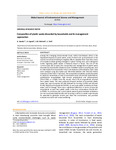Composition of plastic waste discarded by households and its management approaches

View/
Date
2019Author
Gwada, B.
G. Ogendi
Makindi, S.M.
Trott, S.
Metadata
Show full item recordAbstract
Among the emerging environmental issues within Sub-Saharan Africa is the haphazard disposal of plastic waste, some of which end up downstream in the marine environment leading to negative effects. Notably there have been cases of humpback whales getting entangled in ‘ghost’ fishing nets, and endangered turtles ingesting plastic wastes in Watamu beach in Kenya. The aim of the current study was to assess the composition and management of plastic waste discarded by households in Watamu ward. Stratified random sampling was used to collect data from households in four sub-locations within Watamu ward. Data were analysed using descriptive and inferential statistics (the Freeman-Halton extension of the Fisher’s Exact test). The composition of plastics usually discarded as waste by households in order of dominance were low density polyethylene, polyethylene terephthalate, high density polyethylene and polypropylene (FH=37.959, p = 0.000). From the results, only 0.7% of respondents recycled their plastic waste. The most preferred disposal method of household plastic waste was open dumpsites (61.4%) followed by burning (12.9%) and discards (6.4%). Majority of respondents (93.6%), re-use some plastic containers for food, water, and oil storage. There was a significant difference in terms of how the respondents re-used their plastic waste in the four sub-locations (FH=36.437, p=0.005). In conclusion, the current plastic waste disposal methods at Watamu are not environmentally friendly and recycling is still at a smaller scale despite its potential to generate income and clean the environment, and promote ecosystem services and human well being.
